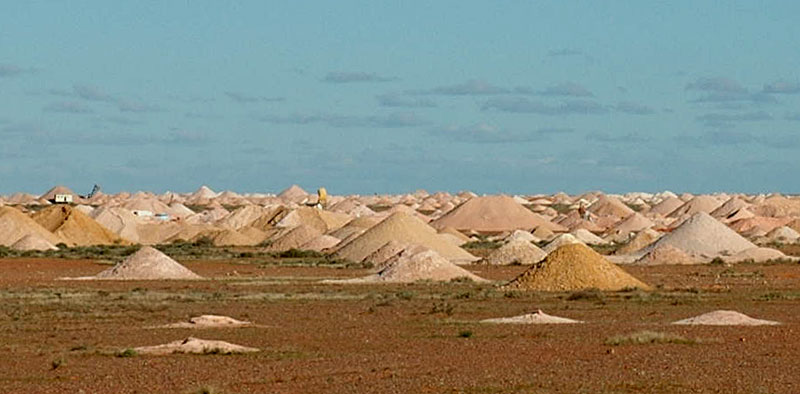@sozobe,
I might talk about Coober/the Lands, first ,because they are more recent.
Coober Pedy is an opal mining town. That's why it's there. Opals.
Here's how Wikipedia opens its entry:
Quote:Coober Pedy is a town in northern South Australia, 846 kilometres north of Adelaide on the Stuart Highway. At the 2006 census its population was 1,916 (1,084 males, 832 females, including 268 indigenous Australians).[1] The town is known as the opal capital of the world because of the quantity of precious opals that are mined there. It is also famous for most of the residents living below ground, mostly in old mines refurbished, due to the scorching daytime heat. The name 'Coober Pedy' comes from the local Aboriginal term kupa-piti, which means 'boys' waterhole'
http://en.wikipedia.org/wiki/Coober_Pedy,_South_Australia
White people got interested in the place in 1915, because we coulde make money.
Lots of people live in dugouts, because of the extreme heat. Wiki calls them caves, but they aren't, they're bloody dugouts!!
They can be very elaborate and comfortable.
Often, modern ones are not completely underground, but dug into a hill, with normal front door and front windows.
They are great for the heat, and the walls are fascinating, but they tend to be kind of musty and dusty...bad for people with hayfever.
We stayed in a dugout motel last time I was there, so I can attest to this in person. More of that motel later!
It is desert and heat out there. It's real outback.
Flying in is fascinating. There is a daily service to and from Adelaide, in a prop plane that seats about 28, I think. It is a tourist mecca, so the plane can be very full. It seems to attract Germans above all else...though apparently it is also big with Japanese. Lots of signs are multi-lingual for this reason.
The plane is generally filled with Adelaide professionals, flying in to drive off to remote communities to deliver various services.
There are also generally lots of eager looking tourists, lots of them hardened back-packers, with mighty thews and khaki-ish ensembles, with ginormous and battered packs.
Other tourists have huge suitcases (especially the Germans, again)...to the great irritation of those trying to pack them into the weeny cargo hold. (They do that out of earshot in Adelaide, but oh boy, you can hear them in Coober!
There is also a sprinkling of hardy Coober Pedy-ites, some of them battered, eremitic looking chaps with long beards and very forbidding miens. These are the opal miners.
There are also always groups of Aboriginal people...some from remote communities. The older women from these communities are generally dressed in the colourful, flowing rayon skirts and shirts that can be bought cheaply from the local stores. Younger women are often in jeans and jackets, like any travelling young woman. The men favour country and western looking shirts and jeans and boots.
It's about one and a half hours, depending on wind and weather, and whether the plane takes off on time.
It's funny! You are directed to get to the airport at sparrow's fart...just as though you are to queue endlessly in international check in. (I got there late once, of which more anon.)
You then go to the wee Rex area, tucked away in the corner of check in.
Because others were paying for my ticket, I generally arrived very early, terrified of missing the plane and wasting their money!
So...you wander through a normal airport...then make your way to your gate.
Then, you have to go way down to the bottom and hike out across the concrete to your plane. Sometimes a reasonable hike. Or..you get in one of those dinky little airport buses, and toodle off to your plane.
Up some flimsy and very bad for arthritic knees stairs....and off you go.
Flying in is said to resemble a lunar landscape.
Me? I saw ant nests.
Thousands and thousands of ant nests. Some obviously made by giant inch ants.....down to wee little sugar ants.
And these ants don't give a good goddam about territory.....lots of their nests are very close to each other...gradually getting farthe and farther away from each other, as you move out from the centre of activity.
See? Ant nests!!! Before rain:


As you can see, it's less than an inch away from Adelaide, as the crow flies:

Here's a great painting of the approach to the place:
http://www.adsoft.com.au/fisher/OutbackSeries/TowardsCooberPedy.htm
Wiki article:
http://en.wikipedia.org/wiki/Coober_Pedy,_South_Australia
More anon.